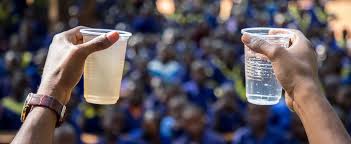
June 16, 2019 - Emergency situation such as disasters are usually dangerous situation that calls for immediate action which poses immediate risks to health, life, environment or property. In such situation along with shelter and food, clean drinking water is among the highest priority to prevent public to illness and death from disease. Point-of-use systems are proven to be efficient, cost-effective, easy to use and highly portable to deliver clean drinking wtare in emergency situation.
Thus, this study aimed to developed a new low-cost point-of-use portable water purification device for emergency use. This portable water filtration device is in conical shape and divided into three compartments namely inner cap, conical section and bottom rim. A portable water filtration device where filter media is positioned between inner cap and conical section. Filter media used in this cellulose paper coated with silver nanoparticles via chemical reduction method. The raw water is pour through the pores of inner cap and filter media and filtered by flow of gravity. The filtered water go through integral sleeve to bottom rim with mesh and can be collected by any type of container. This prototype was tested in terms of its efficiency in providing clean drinking water. Low turbid water samples were more suitable and met the drinking-water quality standards (WHO and Malaysian Drinking Water Quality guidelines). Sustainability criteria scores also indicated it is suitable to be used in any emergency situation. The portable water filtration device has simple parts, low weight, potable, quick filtration process, easy assembly and easy use by anyone. The potable water filtration device can be applied for various applications such as emergency situations such as disasters, primitive environment or economy conditions where electricity is no longer available as a power.
Although mobile water purification units operated at relief centres during emergency situation have its own advantages in supplying high volume of water within a short time, these units needs electricity and pump to be operated. However, electricity shortage during emergency situation such as flood has resulted operation of these mobile water purification units disrupted. Although other common treatment methods such as boiling and chemical treatment can be applied yet these methods are not ideal especially during emergency situation. On the other hand, trucked water is expensive, difficult in terms of logistics, and ineffective, considering the poor facilities used to boil and store water.
Although SODIS and chlorination technologies are suitable for emergency use, they depend on UV penetration and chlorine disinfection efficiency, respectively. Thus these technology are unsuitable during emergency use. Low-cost antibacterial filters, namely, ceramic, polyurethane and agricultural waste have been coated with silver nanoparticles have been used for point-of-use water treatment. Although ceramic filters coated with silver nanoparticles can remove 97.8%–100% of E. coli, the concentration of silver in the effluent exceeds the drinking-water quality standards. Incorporating silver into ceramics involve combustion, long preparation time with low flow rate, require regular cleaning, their performance declines with use because of the accumulation of impurities on the filter element surface, and they are prone to breakage. Using polyurethane foam is unsuitable for emergency applications because of the complex procedure of polyelectrolyte multilayer modification. Rice husk ash used as activated carbon, which contains nearly 95% of silica mass, is a renewable resource for silver nanoparticle immobilization. However, the preparation of rice husks requires combustion before being coated with silver nanoparticles.
Nanotechnology via silver nanoparticles provides a new way to supply clean drinking water through point-of-use water treatment during emergencies. Silver ions from the silver nanoparticles bind to the thiol group of the membrane protein and lead to membrane damage. Interference of silver ions in DNA replication can also result in cell death. The mechanisms of silver nanoparticles as antibacterial agents is due to direct contact with the cell wall of the contaminant organism. Silver nanoparticles inhibit microbial growth by attaching to the cell membrane, damage the cell’s major functions, such as enzyme-signal regulation, cell oxidation, and respiration. Bactericidal activity of silver nanoparticles depends on the electrostatic attraction between the positively charged silver nanoparticles and the negatively charged cell surfaces of E. coli.
Advantages :
- Low cost material
- Low energy input (no pump required)
- Works by flow of gravity
- Minimizes electricity usage
- No any cleaning required
- No chemical additions
- Non-toxic and easy to distribute
- Sustainable point-of-use water treatment for poor countries

Assoc Prof Dr Sarva Mangala Praveena
Faculty of Health and Medicine Sciences
Email : smpraveena@upm.edu.my
Date of Input: 18/06/2019 | Updated: 01/07/2019 | asrizam
MEDIA SHARING
























